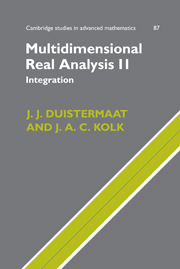Preface
Published online by Cambridge University Press: 21 December 2009
Summary
I prefer the open landscape under a clear sky with its depth of perspective, where the wealth of sharply defined nearby details gradually fades away towards the horizon.
This book, which is in two parts, provides an introduction to the theory of vectorvalued functions on Euclidean space. We focus on four main objects of study and in addition consider the interactions between these. Volume I is devoted to differentiation. Differentiable functions on Rn come first, in Chapters 1 through 3. Next, differentiable manifolds embedded in Rn are discussed, in Chapters 4 and 5. In Volume II we take up integration. Chapter 6 deals with the theory of n-dimensional integration over Rn. Finally, in Chapters 7 and 8 lower-dimensional integration over submanifolds of Rn is developed; particular attention is paid to vector analysis and the theory of differential forms, which are treated independently from each other. Generally speaking, the emphasis is on geometric aspects of analysis rather than on matters belonging to functional analysis.
In presenting the material we have been intentionally concrete, aiming at a thorough understanding of Euclidean space. Once this case is properly understood, it becomes easier to move on to abstract metric spaces or manifolds and to infinitedimensional function spaces. If the general theory is introduced too soon, the reader might get confused about its relevance and lose motivation. Yet we have tried to organize the book as economically as we could, for instance by making use of linear algebra whenever possible and minimizing the number of ∈–δ arguments, always without sacrificing rigor.
- Type
- Chapter
- Information
- Multidimensional Real Analysis IIIntegration, pp. xi - xiiPublisher: Cambridge University PressPrint publication year: 2004

